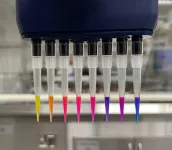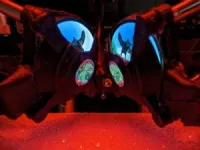(Press-News.org) When Senior Scientist Jonathan Grimm came to Janelia 13 years ago, he didn’t know much about fluorescence or fluorescent dyes. But as an organic chemist who had been working in drug discovery at Merck, he certainly knew a thing or two about medicinal chemistry.
On a whim, Grimm and Janelia Senior Group Leader Luke Lavis decided to try using a mainstay medicinal chemistry reaction Grimm had picked up in the pharmaceutical industry to improve centuries-old dye chemistry. They thought this approach could allow access to completely new, previously inaccessible rhodamines – molecules Lavis had been working to make brighter and longer-lasting so they could be used to better image cells under powerful microscopes.
The result was the start of what would become the now ubiquitous and indispensable Janelia Fluor dyes, bright, photostable, cell-permeable fluorescent probes that allow biologists to see the molecules inside cells. More than a decade after they were first unveiled, these fluorescent dyes that span the color spectrum have become a staple of biology labs worldwide.
Using a similar approach, Grimm, Lavis, and their collaborators have now released the culmination of their years of work: a comprehensive collection of additional rhodamine-based fluorescent dyes – a whole new set of far-red shifted dyes that can penetrate deeper into tissue and are good for in vivo imaging, making them vitally important for biologists. The team also shared their approach -- the novel chemistry they developed to synthesize the dyes and insights that provide a roadmap for designing future probes.
“Along the way we applied or modified or came up with totally new ways to make rhodamines that have pretty broad scope and that enabled us to make so many dyes relatively quickly,” Grimm says. “This is probably the most comprehensive work we’ve done with rhodamines so far.”
Creating a comprehensive collection
The latest project started at the onset of the COVID-19 pandemic in early 2020. The team had just released research detailing the novel chemistry they used to expand the Janelia Fluor dye palette. Next, they wanted to see if they could apply what they learned about optimizing the Janelia Fluor dyes to other types of rhodamine-based dyes, while also further improving the chemistry used to synthesize them.
As the world shut down, Grimm and Lavis planned new chemistry—including completely novel chemical reactions—that sought to rationally incorporate the lessons learned from the Janelia Fluor dyes into other classic but suboptimal rhodamines. A few months later, Grimm got back into the lab and began seeing if their work on paper could translate to the real – and sometimes unpredictable – world of organic chemistry. With COVID precautions in place, Grimm worked alone in the lab optimizing the chemistry and creating the first new dyes.
“It probably would have happened anyway, but for better or for worse, when there is nothing else to focus on, or the things to focus on were bad—as 2020 was for everybody—chemistry was a nice distraction,” Grimm says.
The new research lays out the culmination of the team’s work over the past three-plus years. Unlike the traditional Janelia Fluor dyes, which are characterized by an appendage called an azetidine ring, the other rhodamine-based dyes have different substituents protruding from other parts of their molecular structures. Armed with knowledge from optimizing the JF dyes, the team modified these other areas on the older rhodamine dyes to alter their color, brightness, photostability, cell permeability, and other characteristics.
The result is a whole new set of rhodamine-based dyes for imaging. The team was also able to devise several new ways to make classic rhodamine dyes, enabling them to create dozens of functional versions relatively quickly.
“We had known for a long time how changing the functionality on the ‘top’ of the molecule affects the colors of the fluorophores, but we also figured out that this strongly affects the chemical properties of the dye,” Lavis says. “We exploited that in different ways to make bright, red-shifted imaging agents.”
The final chapter
While this isn’t the end of the story for rhodamine dyes, the work is likely moving in a different direction. Now the team is focused on designing reagents that are specifically tailored for use by their biologist collaborators, working to build the very best tools they can with the knowledge they’ve gained.
“We can make any rhodamine dye we would ever want with this chemistry, and so the big question is what do we make next,” Lavis says. “It’s not what can we make but what should we make.”
Grimm says developing this expansive set of rhodamines, which took over a decade, is a testament to HHMI Janelia’s support of long-term efforts that are beneficial to the wider scientific community. Having permanent staff scientist positions at Janelia also enables Grimm and other senior scientists to provide continuity to a large project like the Janelia Fluor dyes. Four of the researchers on the most current publication were also on the very first rhodamine dye paper the lab published, in 2011.
For Grimm, it also means he gets to do what he loves – be in the lab, do chemistry, and create tools that are useful to biologists. And, more than 13 years later, he’s also learned a thing or two about fluorescent dyes.
“It is very satisfying to have this timeline of papers that show all that we’ve done over the years, and it all started with just one random reaction based on a little calculation that Luke did, which itself was enabled by a synthetic method that we just happened to pursue, on a whim, simply to make dye synthesis a little easier,” Grimm says. “Even if a calculation looks great, it doesn’t always pan out that way. In this case, it was dead on, and it certainly paid off.”
END
A fork in the rhod: Janelia researchers unveil comprehensive collection of rhodamine-based fluorescent dyes
2023-12-08
ELSE PRESS RELEASES FROM THIS DATE:
The Gerontological Society of America congratulates new 2023 awardees
2023-12-08
The Gerontological Society of America (GSA) — the country’s largest interdisciplinary organization devoted to the field of aging — is proud to acknowledge the work of 34 outstanding individuals through its prestigious awards program.
GSA salutes outstanding research, recognizes distinguished leadership in teaching and service, and fosters new ideas through a host of awards. Nominated by their peers, the recipients’ achievements serve as milestones in the history and development of ...
Texas A&M Institute part of national effort to harness nuclear laser fusion for limitless energy
2023-12-08
Nuclear fusion, the process that powers the sun, is the ultimate source of energy for all life on Earth. On the sun, deuterium and tritium nuclei combine to produce an alpha particle (the nucleus of a helium atom) and a neutron. The dream is to do the same down here, on Earth, in a controlled manner.
It’s for good reason that harnessing fusion energy is one of the greatest scientific and technological challenges of the 21st century. Fusion requires the fuel to be heated to more than 100 million degrees (10 times hotter than the core of the sun). Practical fusion energy also requires that the burning fuel is kept at these hot temperatures long enough so that energy ...
How health system hesitancies contributed to COVID risks
2023-12-08
More than 1.2 million people have died in the United States during the COVID-19 pandemic to date, more documented deaths than any other nation on Earth.
While many have attributed the high death toll on widespread personal hesitancy to wear masks, avoid crowded places or receive vaccines once they were developed, there were several “system hesitancies” that contributed to the tragic outcomes that need addressing, according to an analysis published Dec. 6, 2023, in Health Affairs Forefront.
The analysis ...
Stand Up to Cancer names Julian Adams, Ph.D., President and CEO
2023-12-08
LOS ANGELES – December 8, 2023 – Stand Up To Cancer® (SU2C) today announced the appointment of Julian Adams, Ph.D., as president and chief executive officer, which will be effective on January 1, 2024. Adams had previously served on SU2C’s Scientific Advisory Committee since 2008, and officially joined SU2C in July 2023 in the newly created position of chief science officer. He succeeds Russell Chew, who joins SU2C’s Board of Directors.
Adams is a longtime oncology researcher and pharmaceutical industry senior executive specializing in drug discovery and development in cancer. With this appointment, Adams assumes management responsibility for SU2C’s overall ...
Immersive VR goggles for mice unlock new potential for brain science
2023-12-08
Northwestern University researchers have developed new virtual reality (VR) goggles for mice.
Besides just being cute, these miniature goggles provide more immersive experiences for mice living in laboratory settings. By more faithfully simulating natural environments, the researchers can more accurately and precisely study the neural circuitry that underlies behavior.
Compared to current state-of-the-art systems, which simply surround mice with computer or projection screens, the new goggles provide a leap in advancement. In current systems, mice can still see the lab environment peeking out from behind the screens, and the screens’ ...
Racial and ethnic differences in hospice use among Medicaid-only and dual-eligible decedents
2023-12-08
About The Study: In this study, in both Medicaid only and dual-eligible populations, Hispanic and non-Hispanic Black individuals had the lowest odds of receiving hospice, and Hispanic individuals had the highest odds of a short hospice stay. Knowledge about, access to, and acceptance of hospice may be lacking for these low-income individuals. Further research is needed to understand barriers to and facilitators of hospice use for people with nursing facility stays.
Authors: Julie ...
County–level variation in preterm birth rates
2023-12-08
About The Study: In this analysis of U.S. county-level preterm and early preterm birth rates, substantial geographic disparities were observed, which were associated with place-based social disadvantage. Stability in aggregated rates of preterm birth at the national level masked increases in nearly 1 in 6 counties between 2007 and 2019.
Authors: Sadiya S. Khan, M.D.,M.S., of the Northwestern University Feinberg School of Medicine in Chicago, is the corresponding author.
To access the embargoed study: Visit our For The Media website at ...
T cells tackle new 'Pirola' SARS-CoV-2 variant
2023-12-08
LA JOLLA, CA—In August, researchers detected a new SARS-CoV-2 "variant of concern" in patients in Israel and Denmark. Since then, this variant, dubbed BA.2.86 or "Pirola," has made its way around the globe. The Pirola variant has raised alarms because it is highly mutated. In fact, Pirola is as mutated as the Omicron variant was, compared with the early SARS-CoV-2 variant included in the original vaccinations.
As Pirola spreads, researchers at La Jolla Institute for Immunology (LJI) are investigating whether COVID-19 vaccines (or previous ...
MIT engineers design a robotic replica of the heart’s right chamber
2023-12-08
MIT engineers have developed a robotic replica of the heart’s right ventricle, which mimics the beating and blood-pumping action of live hearts.
The robo-ventricle combines real heart tissue with synthetic, balloon-like artificial muscles that enable scientists to control the ventricle’s contractions while observing how its natural valves and other intricate structures function.
The artificial ventricle can be tuned to mimic healthy and diseased states. The team manipulated the model to simulate conditions of right ventricular dysfunction, ...
New cause of diabetes discovered, offering potential target for new classes of drugs to treat the disease
2023-12-08
Dec. 8, 2023
Contact:
Bill Lubinger
216.368.4443
william.lubinger@case.edu
Ansley Kelm
678-313-6525
Ansley.Kelm@UHhospitals.org
CLEVELAND—Researchers at Case Western Reserve University and University Hospitals have identified an enzyme that blocks insulin produced in the body—a discovery that could provide a new target to treat diabetes.
Their study, published Dec. 5 in the journal Cell, focuses on nitric oxide, a compound that dilates blood vessels, improves memory, fights infection and stimulates the release of hormones, among ...







